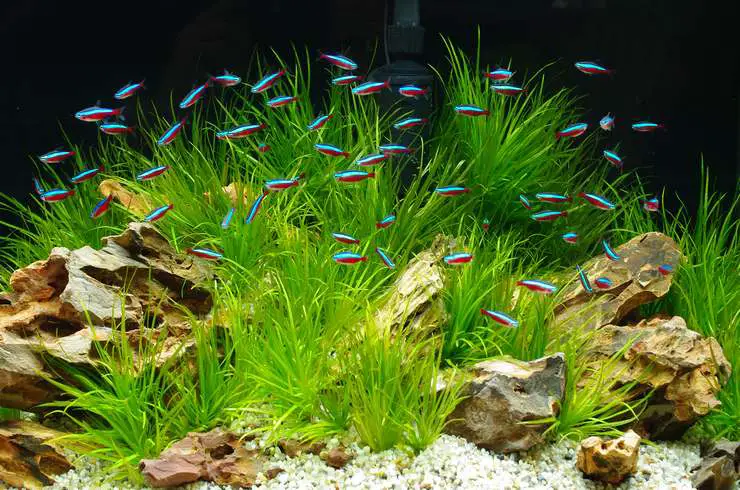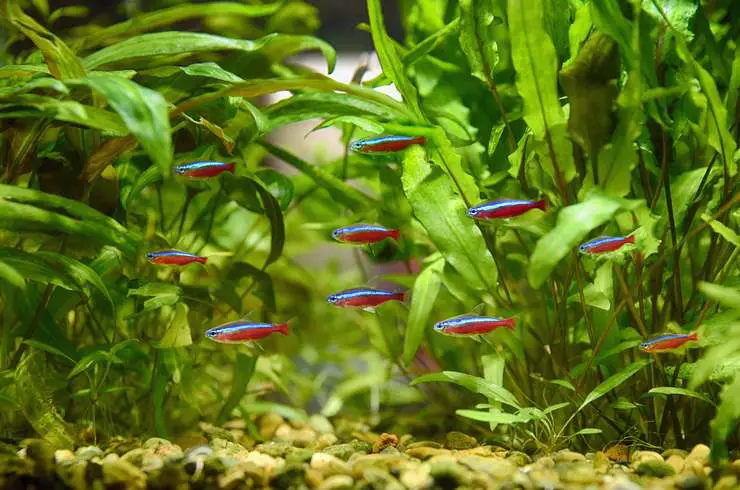Small characins from South America are popular among hobbyists. They are active fish with a bright, eye-catching color. Among them, neons stand apart, a distinctive feature of which is the presence of a special shiny strip along the body, flashing in the reflected light like a light. It is so bright that it resembles the lights of neon advertisements in the night city.
General information
Red neon or cardinal tetra (Paracheirodon axelrodi) is a tropical freshwater fish from the Kharacin family. It can rightfully be called one of the most beautiful aquarium fish. A large flock of neons, especially against the background of thickets of aquatic plants, looks so mesmerizing that it is difficult to take your eyes off them. The nature of red neons is peaceful.
In appearance, the fish resembles its relative – blue, or ordinary, neon. The main difference is the length of the bright red stripes on the sides of the body. If in blue neon it starts from the middle of the body, then in red it stretches through the entire lower body. Also, unlike its counterpart, red neon is larger.
A fish are sensitive to the conditions of keeping, which does not like changes in water parameters. It is not recommended to add red neons to freshly started aquariums.
The first scientific description of red neon was made in 1956. The fish were brought to our country after 5 years. At first, individuals caught in nature were supplied to the market. Nowadays, they are mainly bred on specialized farms.
Appearance
Red neon has a slightly elongated and flattened body on the sides. The fins are small, completely transparent, sometimes with a blue-white edging. The head is small with bluish-green eyes. The maximum size of the fish is about 5 cm.
Of all the representatives of the genus, neon red stands out as the brightest color. The back has an olive green color, and on the sides of the body, there are two wide stripes: blue above with a characteristic neon glow due to reflected light, and below it is bright red, stretching from head to tail.
Habitat
The homeland of red neon is South America. Fish are widely represented in the basins of rivers such as the Rio Negro and Orinoco.
This species prefers slow forest channels and backwaters. Neons are kept in flocks in the middle layers of the water. The rivers in which they live flow under the dense canopy of tropical rain forests, which creates twilight in the water. Decaying leaves, regular rains, a large layer of silt make the water soft and acidic. It is rich in humic substances and therefore has a characteristic brownish tint (“black water”).
Care and maintenance
Red neon is a schooling fish, it is necessary to keep at least 6 individuals. Aquariums with a volume of 60 liters or more are best suited. The container should be equipped with a lid because the fish are very active and can easily jump out of the aquarium.
When decorating, it is best to focus on the natural style, that is, use natural decorations: stones, driftwood. It is better to cover the soil with sandy or small pebbles. With the help of decor, it is necessary to create a large number of shelters. A flock of red neons will work best in aquariums with dense aquatic plants. They can be landed along the back and sidewalls, leaving a swimming area in the center. You can use any popular species: Vallisneria, Echinodorus, Cryptocoryne, ferns.
Neon red does not like bright lighting, but plants may need it, so it is best to create a slight twilight using species floating on the surface.
Neons are very sensitive to nitrogenous compounds in the water, so they are not recommended to be planted in freshly started aquariums. The more stable the water parameters are, the more comfortable the fish will be. It is necessary to install a filter of a suitable power in the aquarium, but it is better not to create a strong current. Additional aeration of water using a compressor (especially at night) will not be superfluous. Also, install a thermostat to maintain a comfortable water temperature (23-26 ° C). Once a week, you need to change 20% of the water in the aquarium. To create the “black water” effect, it is recommended to use a special conditioner with natural peat extract – Tetra ToruMin.
Compatibility
Neon red is a peaceful schooling fish that gets along well with most commensurate species. They can be easily settled with other types of neons (black, blue), tetras, pristella, nannostomuses, apistograms, rasbora, peaceful catfish, shrimps. 
In no case should you add fish to neons, which they can fit in your mouth? With a high degree of probability, they will be eaten, because in nature they are one of the links in the food chain.
Well compatible with living plants – they do not bite or pull them out.
Feeding the red neon
The natural diet of red neon mainly consists of small crustaceans, worms, and other invertebrates.
When kept at home, fish perfectly eat high-quality dry food. It is better to refuse live and frozen food because they are not balanced and can pose a threat of contamination of the aquarium. When feeding, it must be borne in mind that the mouth of neons is small, so the food must be of the appropriate size.
Good choices are:
- Tetra Micro Food series. This line has been specially designed to feed smallmouth fish. The food is available in the form of chips, granules, pellets, and sticks. It is completely balanced, combining both animal and plant ingredients to support the health and vitality of your fish.
- Foods with natural carotenoids such as Tetra Rubin and TetraPro Color help enhance the natural color of fish. The red stripe on the neons will look even brighter.
- TetraMin Flake Basic Food is also suitable for feeding red neons. It is made with over 40 quality ingredients and fortified with vitamins and prebiotics.
- Diversify your pets’ diet with natural treats in nourishing jelly from the Tetra FreshDelica series. Neons will definitely like delicious bloodworms, daphnia, or brine shrimp. In this case, there is no risk of introducing infection into the aquarium.
It is necessary to feed red neons several times a day with a small portion of food, which the fish will completely eat in a few minutes. Don’t overfeed your pets, neons are prone to obesity!
Reproduction and breeding
Breeding neons is not a simple process. This is primarily due to the fact that spawning occurs in very soft water, otherwise, the eggs will simply not be fertilized. Caviar is also light-sensitive, so the aquarium has to be shaded.
The complexity begins even at the stage of selection of producers because gender dimorphism in fish is not expressed. Males are slimmer than females, the edge of their anal fin is convex.
It will not work to distribute red neons in a common aquarium, therefore it is necessary to prepare a separate spawning container with a volume of 15-20 liters with a water level of about 20 cm. The water should be “old”, with stable parameters: T = 24-26 ° C, pH = 5.0- 5.5, GH <3. Small-leaved plants such as Javan moss should be placed on the bottom.
A week before spawning, producers are seated and abundantly fed. After the transfer to the spawning grounds, with courtship of the male for the female begins, which lasts up to 7 days, after which spawning occurs at night. The female is able to lay up to 400 small eggs, which fall to the bottom. Breeders should be removed from the aquarium to avoid eating their own caviar. Eggs in red neon do not tolerate bright light, so it is advisable to shade the container on three sides.
The incubation of eggs takes about a day. The fry begins to feed on their own 5-6 days after hatching. At first, small fish hide among the plants, a luminous strip appears at the age of 3 weeks, and an adult color – after another two weeks. Red neons become pubertal at the age of 8-10 months.

